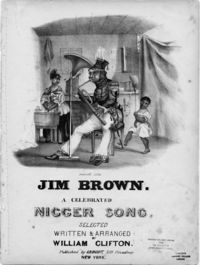Annotation:Jim Brown: Difference between revisions
(Created page with "=='''Back to [[{{BASEPAGENAME}}]]'''== ---- <p><font face="garamond, serif" size="4"> '''JIM BROWN.''' American, Minstrel Air (2/4 time). G Major. Standard tuning (fiddle). AB...") |
No edit summary |
||
| Line 2: | Line 2: | ||
---- | ---- | ||
<p><font face="garamond, serif" size="4"> | <p><font face="garamond, serif" size="4"> | ||
'''JIM BROWN.''' American, Minstrel Air (2/4 time). G Major. Standard tuning (fiddle). AB. | '''JIM BROWN.''' American, Minstrel Air (2/4 time). G Major. Standard tuning (fiddle). AB. | ||
[[File:jimbrown.jpg|200px|thumb|left|Jim Brown songsheet, c. 1836]] | |||
The figure depicted in the cover the to the sheet music to the left is dressed in a band costume. It has been suggested that the cover caricatures African-American bandleader Francis Johnson, who led a very successful brass band in Philadelphia, and who had a national reputation for his music (see [[Philpadelphia Fireman's Ball]]). The cover also depicts the man as a variant of the black 'dandy' (albeit in uniform rather than evening-dress), a stereotypic figure in the minstrel era that started early with such songs as "[[Zip Coon]]" and "[[Long Tail Blue]]." | |||
<br> | <br> | ||
<br> | <br> | ||
Revision as of 06:18, 18 May 2013
Back to Jim Brown
JIM BROWN. American, Minstrel Air (2/4 time). G Major. Standard tuning (fiddle). AB.

The figure depicted in the cover the to the sheet music to the left is dressed in a band costume. It has been suggested that the cover caricatures African-American bandleader Francis Johnson, who led a very successful brass band in Philadelphia, and who had a national reputation for his music (see Philpadelphia Fireman's Ball). The cover also depicts the man as a variant of the black 'dandy' (albeit in uniform rather than evening-dress), a stereotypic figure in the minstrel era that started early with such songs as "Zip Coon" and "Long Tail Blue."
Source for notated version:
Printed sources: Chaff (The Complete Preceptor for the Banjo), 1851; p. 14.
Recorded sources:
